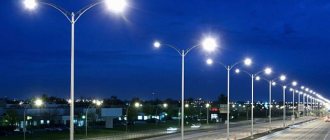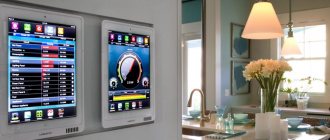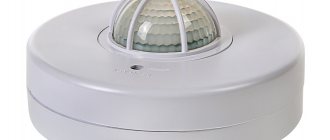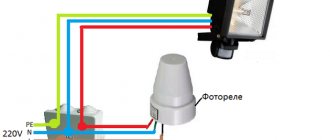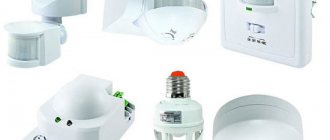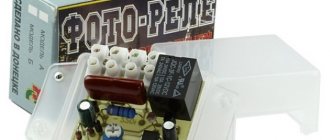Light on and off timers are electrical devices that can be used to organize automatic lighting control. Suitable for domestic and industrial consumers. Including timers in the lighting network design can significantly reduce the cost of expensive electricity and simplify the control of outdoor lighting, because in this case, there is no need to be on site to turn the light on and off. There are a large number of models of timers and switches that are used for different lighting networks.
Lanterns with timer for street lighting
Light switch with timer
Lighting network diagram with timer
Lighting system in a smart home: design and operating principle
The point of a smart lighting system is the ability to control light using voice or automated scripts. The system allows you to control the operation of lighting fixtures installed inside and outside the house.
You can immediately purchase smart lighting devices. For example, Sber E14 or Sber E27 lamps. However, ordinary devices can also be easily turned into smart ones. It is enough to combine them with smart sockets and switches. LED strips, recessed and local lamps are suitable for this purpose.
Let's move on to the components of the light control system. This:
- Power light control unit that receives commands and distributes them.
- Controllers.
- Control panels, remotes.
- Smart switches.
- Dimmers for adjusting light levels.
- Motion sensors that respond to the presence and absence of a person in a room or in a local area.
Important! Sometimes household appliances whose operation you want to automate are connected to a smart lighting system.
To connect devices to the electrical network, special devices are used - controllers. Detectors and sensors are used to record processes. They detect changes in light levels and react to the movements of the inhabitants of the house, after which they transmit signals to the controller. The device automatically processes the information and turns on the lights.
For even greater convenience, you can set up voice control of the system. For example, through virtual assistants - Siri, Alice and Google Assistant.
Smart light system in the house
Where can I buy
You can purchase devices as quickly as possible at your nearest specialty store. The optimal option, in terms of price-quality ratio, remains purchasing from the AliExpress online store. Mandatory long waits for parcels from China are a thing of the past, because now many goods are in intermediate warehouses in destination countries: for example, when ordering, you can select the “Delivery from the Russian Federation” option:
| Livolo switch with timer up to 30s | Electronic socket with digital timer | Smart switch with Wi-Fi and timer, with remote control |
| Tuya Wi-Fi Smart Switch with Timer, 10A | Switch SMATRUL 10-16A, timer, voice control | Tuya Smart Life mini switch with app and timer |
Applications and benefits of smart lighting
Smart lighting is widely used both in large private houses and in city apartments, as well as in industrial premises, offices and hotels. Advantages of the technology:
- The ability to control the lights on and off even when you are away from home is convenient if you are worried that you forgot to turn off the lights or electrical appliances.
- Reduce utility costs by reducing energy consumption.
- A simple and intuitive lighting control system that any family member can handle.
No more searching for switches in the dark and wondering if you turned off the lights before leaving. All processes will be automated. All you have to do is enjoy the comfort and try out the advanced features.
Controlling a smart lighting system
Quick setup guide
This tool works without special settings, since it is capable of independently emitting sound waves that are reflected from objects. If they notice a moving object, then the frequency of the wave changes, and the lighting starts accordingly.
The noise motion sensor for lighting is configured using regulators on the body Source uk-parkovaya.ru
All that is needed for the installation to operate correctly is to apply voltage and connect the neutral conductor.
Smart lighting functionality
A smart lighting system gives new opportunities that are very useful in everyday life. Let's look at five important functions.
Turning lamps off and on using a timer
Lighting automation involves the use of timers. You can set certain time intervals in the program when the light turns on and off.
It is not necessary to set the same time for all lamps. For example, in the late afternoon you can automatically turn on the main lighting, and at a later hour - sconces, floor lamps and night lights. In the morning, the timer function is also indispensable - turning on the light will help you wake up without an alarm clock.
Automatic light control
The smart lighting system has several control options. You can use remote controls designed separately for each room. The buttons on the device are programmed to control all the lighting fixtures in the room. You can control the light using the remote control from any corner of the house or apartment.
The second method is to install special devices for complete automation of control. The most common option is motion sensors that respond to the appearance of a person. The light will turn on as soon as you enter the room and turn off a few minutes later when you leave.
Motion sensors have one drawback. If you enter a room and want to be there without light, you still have to go to the switch. However, this minor drawback does not detract from the convenience of the design.
Changing the brightness of the light
The smart lighting system allows you to easily adjust the brightness of lamps using special devices - dimmers. They allow you to manually change the lighting power.
There are four ways to change settings:
- Using buttons on wall panels.
- Setting the automatic brightness change mode after a certain time.
- Control using remote control.
- Manual setup.
Lighting depending on the time of day and amount of natural light
You can install special sensors that will record changes in light levels in different rooms. When the room becomes dark, the lamps will immediately turn on. The sensor also reacts to light saturation. The darker the room, the brighter the light is.
This lighting system is used not only inside the house, but also outside. Smart lamps are often placed in areas near light-loving plants so that plantings do not suffer from the lack of sunlight.
Creating lighting scenarios
Using the light scenarios function, the program remembers certain combinations of lamps turned on at the same time. If necessary, the system can repeat them - just press a button on the control panel.
Managing the functionality of the smart lighting system
Lighting timer type TO-47
General view of the TO-47 timer
Models of the TO-47 series are designed for automatically turning on and off lighting networks with halogen and incandescent lamps on landings and other premises. The device turns on the lighting for a period of 1 to 7 minutes. The maximum load on the device is 3.5 kV.
Staircase lighting control
Device connection options
The light off timer can operate in three-wire and four-wire electrical networks (the products are specially equipped with a switch for the number of wires).
- When choosing scheme No. 1 (three-wire networks), the circuit is assembled without the possibility of connecting an additional lighting load after the switch;
- Scheme No. 2 is four-wire with the ability to connect additional lamps (lamps) via a switch.
Connection procedure
- Mount the TO-47 modular timer on a DIN rail using a special latch (for modular devices);
- Connect external buttons according to the electrical diagrams.
Manual control
The TO-47 is controlled by a switch knob located on the front panel of the device.
When moved to the position with the “Lamp” icon, the contacts close and the backlight starts to turn on (before the lever is forced to move to its original position).
When the lever is moved once to the “double circle” position, a timer is activated with a specified time shutdown setting.
If the timer is controlled by an external button, the lever must be moved to the “double circle” position.
To increase the operating mode, a switch is provided in the “On” position. When the timer switch is turned on, the contacts are constantly closed; the contacts open when switched to the “Off” position.
Lighting controller
The controller in a smart home is a microprocessor that contains the “intelligence” of the system. The device evaluates incoming commands and selects the appropriate algorithm to perform the action.
Controllers can be installed directly into luminaires. Designers call this a distributed intelligence system. This scheme is considered more flexible and convenient to manage.
You can install one controller for the entire system. This scheme is called centralized. This solution is suitable for houses and apartments where there are not many rooms.
Controller for smart lighting system
Time relay, timer. Setup and connection diagram
An electronic time relay is designed to count time intervals, automatically turn on/off various electrical equipment (lighting, heating, etc.) after a specified period of time during a repeating weekly cycle.
For example: to turn on and off the lighting of a courtyard, park or street; to turn on and off the night lighting of staircases of apartment buildings; to turn on and off advertising signs and display windows at night; to control the inclusion of electric heating in a house; for automatic watering of plants;
to create the effect of presence in the house
Powered by a household power supply, voltage 220 Volts (it is possible to order relays for voltages of 12, 24, 36, 110 Volts). You can program it for the whole week or any day of the week, turning it on and off one or more times during the day. All data are displayed on the liquid crystal display. When the power supply is turned off, it retains the programming mode due to the built-in battery.
The service life of the time relay is from three to five years.
Specifications
ParameterValue
| Rated operating voltage | 220V |
| Mains frequency | 50/60Hz |
| Remains operational when the supply voltage is within | 180V-250V |
| Relay power consumption | no more than 2VA |
| Permissible switching contact current, with active load | 16A |
| Permissible switching contact current, with reactive load | 8A |
| Minimum programming step | 1 minute |
| Maximum programming step | 168 hours |
| Number of on/off programs | 16 cycles |
| Mechanical wear resistance, on/off cycles | 10⁷ |
| Electrical durability, on/off cycles | 10⁵ |
| Programming data storage time when power is turned off | up to 150 hours |
| Accuracy of the watch during the day, at a temperature of +25°C | ≤1 second |
| Overall dimensions (HxWxD) | 86.5x36x65.5 mm |
| Operating temperature range, °C | -10°С~+40°С |
| Relative humidity | 35~85% |
DIN rail mounting (takes two S-type modules), the size of a two-phase circuit breaker. Operate indoors with artificial ventilation and heating control.
Time relay front panel
Purpose of time relay control and indication buttons
Purpose of buttons and indicationsInscription
| Indication of contact activation | ON |
| Programming button | |
| Day of week setting button | D+ |
| Hour setting button | H+ |
| Minute setting button | M+ |
| Setting and current time button | |
| Reset all data button | RESET |
| Mode control button (ON, AUTO, OFF) | MANUAL |
Liquid crystal display
LCD Display Data
At the top of the display: days of the week
MO - Monday; TU - Tuesday; WE —environment; TH - Thursday; FR - Friday; SA - Saturday; SU - Sunday.
The day of the week is set using the D+ . In the middle part of the display: current and programmable time
The time is set using the , H+ and M+
In the lower left part of the display: numbers of on and off cycles
ON - enabled; OFF - disabled; numbers from 1 to 16 are the cycle number.
Cycles are configured using the button In the lower right part of the display: control mode
ON - always on; AUTO - automatic mode; OFF - permanently disabled.
The control mode is set using the MANUAL
Setting up a time relay
It is recommended to start with the RESET (press gently with a thin screwdriver; no force is required). After pressing, the display goes blank and then all elements are displayed, all settings and the current time are reset.
Setting up a time relay begins with setting the day of the week and the current time. We press (with our fingers) and hold the button (hereinafter referred to as clock ) and press the D+ , select the current day of the week, continue to hold down the clock , and use the H+ and M+ to set the current time.
After setting the current time and day of the week, we proceed to programming the time relay.
Programming a time relay
Programming is activated using the button (hereinafter referred to as programming ).
1) Press the programming to turn on the first switching cycle, then use the D+ , H+ and M+ to select the day of the week and switching . 2) Press the programming to turn on the first shutdown cycle, then use the D+ , H+ and M+ to select the day of the week and shutdown . If necessary, you can add several more on and off cycles by adjusting the second, third, etc. cycles.
Time relay connection diagram
Approximate connection diagram for time relay and load
Download instructions (passport) for time relay
Step-by-step instructions for setting up and programming an electronic weekly time relay can be downloaded or printed for free here; a passport describing and assigning time relay control buttons; programming and setting algorithm
download the instructions (passport) for the time relay, in Russian
download the instructions (passport) for the time relay, in English
time relay, time relay buy, electronic timer, TE 15, time relay circuit, time relay 220 Volt, programmable time relay, gravity watering timer, shutdown timer, relay, electronic programmable timer, with non-volatile memory, switching current 16 amperes, full range time from 1 minute to 168 hours, 16 programs, THC 15A, download time relay passport in Russian, download time relay instructions in Russian
Source: https://electromaster.kz/instructions/88-rele-vremeni-elektronnoe-nedelnoe
Smart socket with timer
A smart timer is a compact device that looks like a regular adapter. It needs to be integrated into the outlet, and then connect the household appliance there.
Features of socket timers:
- Power off after a specified period of time.
- Turning on the power at a specific time.
- Remote control over the operation of electrical appliances.
- Calculation of energy consumption.
A socket with a timer is very useful in everyday life. Having installed even the simplest device, you no longer have to worry whether the iron is turned off. Even if you forget about it, the smart system will react and block the power supply.
Using a socket with a timer, you can set the appliances to operate at a certain time. For example, program the coffee maker to turn on in the morning.
Timers on the socket will also come in handy during the holidays. Before the New Year, garlands and other lighting decor appear in homes. Many people forget to turn off their devices before going to bed, which can result in the devices burning out. Smart plugs can help you avoid this fate.
And the main advantage of the system is the ability to compare energy consumption indicators for different devices. It is enough to plug one device into the outlet first and record the measurements. Then you can do similar actions with another device. As a result, you will know which household appliances consume more energy and increase your electricity bills.
Smart socket with timer
Photo relay on timer 555
The 555 sleep timer is a universal one, one of the most common devices for generating single and repeating signals (pulses), stably linked to time intervals. Based on the 555 timer and a phototransistor, it is possible to manufacture a photo relay that operates from a 12V network.
Application
Photo relays based on timer 555 are used to automate lighting networks: external, indoor, etc.
General view of timer 555
Schematic diagram of photo relay with timer 555
Smart switch
A smart switch is a highly technical device that can function automatically. Device design:
- Receiver: a silent pulse relay that records received signals and opens the electrical circuit. The device is controlled using a remote control or smartphone. The miniature receiver can be mounted directly into luminaires or distribution panels.
- Transmitter: design equipped with a compact electric generator. After sending the command, the device generates an electric current, which is transformed into a certain signal. After completing the action, the transmitter transmits information to the smartphone or controller.
A smart switch is a convenient replacement for the usual one. The smart light control lever looks almost the same as a regular one. It does not require connection to a dedicated electrical wiring branch, so it can be located on any surface.
Important! Most models have a dimming function - the ability to change the brightness of the lighting.
Popular brands that produce smart switches: Sonoff, Xiaomi, Vitrum, Delumo. In the assortment of these manufacturers you can find devices that meet the optimal ratio of quality and cost. For example, a budget switch from Xiaomi/Aqara is in great demand.
To install some models of smart switches, you need a neutral wire in the socket box. If it is not there, it is better to give preference to a product that receives power from lamps.
There are versions of voice-activated light switches that do not require a neutral wire in the socket and operate via WiFi. If you choose this option, make sure that the Internet always works smoothly. However, there is a possible inconvenience - turning on the light with a slight delay.
Smart switch option
Setting up the sound sensor
The automatic light switch in the toilet, organized using an acoustic sensor, is traditionally adjusted to an indicator of 40-50 dB. This is precisely the power of the sound coming from an ordinary clap of hands. In order to make this setting, you need to use the multifunction switch located on the switch body.
To configure the infrared motion sensor, you can use the controls on the bottom of the case Source volk1.ru
Motion sensors with any mechanism can be connected to an electrical circuit with a switch Source couo.ru
Dimmer switch
Dimmers are responsible for the brightness of lighting in rooms. With the help of such switches it is easy to achieve both dim and very bright light. To create a spectacular backlight, you can activate the artistic flicker function.
Modern dimmers for a smart home system differ significantly from electromechanical models. If conventional devices only allowed you to adjust the brightness, then new ones are capable of more.
Device advantages:
- Possibility of control using a remote control or voice commands.
- Work on a timer.
- Different algorithms for changing the brightness of the glow.
Some dimmer models are responsible not only for brightness, but also for color rendition. With their help, you can make streams of light warmer and cooler.
Smart Dimmer Switch Option
Recommendations for setting up an ultrasonic sensor
Setting up an ultrasonic type sensor often involves the ability to adjust the duration of the response cycle. That is, the time during which the light will be turned on.
Types of motion sensors for automatic lighting that are suitable for installation inside the house Source elegantss.ru
Most models from the mid-price segment have a control button on the body, with which you can set the period for turning on the lighting.
Lamp control panels
Remote controls are devices for remote control of lighting devices. In terms of functionality, they can be single-channel or multi-channel. The former work only with a specific lamp, the latter - simultaneously with several devices.
Types of remote controls by design:
- Overhead: A panel with a touch screen or keys mounted on the wall.
- Portable: a design that looks almost no different from the control panel for household appliances.
The remote control indicates all possible functions of the selected system. To activate the desired lighting mode, simply press the desired key. A few seconds after this action, the command will be executed.
Remote control for smart lighting
Photo relay device
Motion sensors.
Hurry up to buy at a discount! This device has different names. For example, photocell, light sensor, photosensor or photosensor, light sensor. However, the most common name is “photo relay”. With its help, you can automatically turn on the light in the dark and turn it off in the light.
It is based on photoresistors, photodiodes and phototransistors. When the light becomes weak and insufficient, they change the parameters. When certain values are reached, the contacts in the relay close and power supply to the lamps begins. Accordingly, as illumination increases, the parameters of the photosensitive elements begin to change again, but in the opposite direction, and the contacts open.
Photo relay device for street lighting
When choosing, you first need to decide on the voltage that will be in the network: 220 V or 12 V. Then select the protection class. IP44 can be considered the minimum. The higher the class, the better. This protection marking means that objects smaller than 1 mm in size will not fall into the lamp, and it is reliably protected from rain. It is also worth paying attention to the fact that the operating temperature exceeds the maximum and minimum temperature values.
The output power of the light relay will depend on the total power of the connected lamps and current. To avoid overloads and breakdowns, it is better to take a device with a power reserve.
Photo relay with built-in photosensor AZH-106 IP65
In some models, you can adjust the sensitivity of the photosensor. This is very convenient, for example, in winter when snow falls. The light sensor can perceive the reflected light as dawn and will turn the lamps on and off. It is worth paying attention to the presence of a response delay. By setting it for 5-7 seconds, you will prevent a power outage when light hits the sensor, for example, from car headlights.
Sensors in a smart system
Sensors for smart lighting perform an important function - they activate the automatic switching on of lamps. Let's consider two types of devices that are widely used in the system.
Motion sensors for outdoor lighting
Thanks to motion-sensing devices, the lights will turn on as soon as a person enters the area. A similar effect occurs if a vehicle enters the area. The lighting will turn off a few minutes after the movements stop.
Occupancy sensors for interior light
Internal sensors work the same way as external ones. They also react to human movements and presence. The light will turn on when you enter the room and will remain on until you leave. This is an ideal solution for any room in a house or apartment.
Motion sensor in a smart light system
Advantages and disadvantages of using automatic light switches
Automatic switches are a great way to make life at home easier. This is proven by several advantages:
- significant savings. After all, it is not uncommon for people to forget to turn off the light when leaving the toilet, but the light bulb continues to burn. With an automatic regulator this will not happen, and light costs will be reduced;
- the need to look for the switch will disappear forever, for example, if it is located in a dark corridor;
- safe use. A regular switch is often touched with wet hands, which creates the risk of electrical injury;
- most models do not respond to the movement of pets (otherwise, they can be easily adjusted) to the desired response intensity;
- basic installation. It is installed according to a special scheme that comes complete with the sensor. Therefore, you can do it with simple instructions. The main thing is to have some skill in working with electrical equipment;
- wide range of devices. You can choose different devices based on their appearance, for example, so that they do not accentuate the chosen design, there are a large number of colors.
In addition to the advantages of using auto-on, you should also consider some disadvantages:
- when choosing a cheap model, remember the high frequency of false alarms;
- Correct installation is required to ensure maximum grip while the object is moving;
- high cost of ultra-sensitive auto switches.
Each device is convenient in its own way, so its model must be chosen wisely. How to do this will be discussed in the next section.
Smart light control systems
Many people confuse tools and control systems. We have already talked about the first ones above. We now move on to discuss three possible lighting coordination systems and control tools.
Centralized
Such a system allows you to control all devices in the house and on the site. All lighting devices are united by a “brain” center - a processor. It receives signals and distributes commands between circuit elements. Most often, control is carried out by voice or through applications.
Wireless
If a wireless system is selected for lighting control, the lighting fixtures will be activated using the remote control. The “heart” of the circuit is the radio transmitter. After you press the desired key on the remote control, signals will be sent through it to certain devices.
Hybrid
This control system combines wireless and wired devices. Signals from sensors can be seamlessly transmitted from one device to another. The main thing is to build the scheme correctly.
Smart backlight control
How auto-on works
Automatic switching on of the light, which is also automatic switching off, works according to the following principle: a motion sensor installed inside receives a signal that arrives at a special sensor. As a result, the equipment orders the lamp to turn on. This occurs due to the fact that the object detected by the sensor emits electromagnetic or ultrasonic waves. Accordingly, the device receives a signal and starts the lighting. The operating features of this will be similar regardless of the selected type of sensor.
Sensors for installing an automatic switch in the toilet Source smogem-sami.ru
Outdoor automatic lighting control
Intelligent smart light technology is widely used for outdoor applications. Special sensors are installed that control the operation of street lamps and record changes in natural light. As soon as it gets dark, electrical devices automatically turn on.
The level of illumination depends on the time of day. The darker it is outside, the brighter the lamps will burn. You can “mute” them by changing the setting in the program. If there is no need to illuminate the area in the absence of people, it is enough to set the night mode. In this case, the sensors will react only when a person approaches the house.
Smart outdoor lighting
This is interesting! Thanks to the external control system, the effect of the presence of the owners in the house is created. This discourages intruders from entering private property.
How to choose a motion sensor for installation in a domestic environment
When trying to equip your toilet with a smart switch, you need to decide on the device option that is ideal. To do this, please read the following points.
- Purpose of the sensor. In this case, it is needed for the toilet, so you should take into account possible interference: door movement, interfering objects (decor on the wall, mirror, shelves). In the place where you plan to place the equipment, it is better to get rid of all the listed attributes.
- Mounting method. Even before purchasing, you need to decide which mounting option for the automatic switch will be optimal. There are built-in and surface-mounted options.
- Dimensions and power. Power refers to the intensity of perception of electromagnetic or ultrasonic waves, measured in Hz. As for the size, it all depends on the type of device (the more powerful it is, the larger its body).
- View radius. Another important parameter that is worth considering. It must be correlated with the installation angle.
- Number of customization levels. The sensor setting should not be too sensitive, as false alarms will always be detected.
- The motion sensor to turn on the lighting in the toilet must be used correctly. Most of them are afraid of moisture, so they try not to install them directly with a high level of humidity.
Examples
Demo - all the features of the library
// Demonstration of all library functions #include "GyverTimers.h" void setup() { // Reset the timer and set its period or frequency // All functions return the real period / frequency, which may differ from the entered Timer2.setPeriod(1000); // Set a specific period to 1000 µs (~ 1000 Hz), return the real period in µs Timer0.setFrequency(250); // Set the timer interrupt frequency in Hz, returns the real frequency in Hertz Timer1.setFrequencyFloat(50.20); // Set the frequency more precisely, in fractional numbers, relevant for low frequencies and timer 1 // From this moment on, the timer has already been reconfigured and runs with the selected frequency / period // Connect a timer interrupt, from this moment on, interrupts will start being called Timer0.enableISR() ; // Connect a standard interrupt, channel A, without phase shift Timer2.enableISR(CHANNEL_B, 180); // Enable timer 2 interrupt, channel B, initial phase - 180 degrees Timer1.enableISR(CHANNEL_A, 60); // Connect the interrupt of channel A, set the phase for channel A, available only for timer 1! Timer1.enableISR(CHANNEL_B, 120); // Connect the second interrupt of timer 1, and set the phase shift for this thread // The interrupt will already begin to be called // If suddenly the interrupt needs to be disabled without stopping the timer Timer1.disableISR(CHANNEL_B); // From this point on, interrupt B will no longer be called // If you need to pause the timer COMPLETELY, in hardware Timer2.pause(); // From this moment on, the timer stands still, the contents of the counter remain untouched // Now the timer can be returned to operation Timer2.resume(); // The timer continued counting from the same place // If you need to completely stop the timer and reset the contents of the counter Timer1.stop(); // The timer is stopped, the counter is reset // We return the timer to operation Timer1.restart(); // The timer has been restarted, started counting from the beginning // If you need to return the standard Arduino - timer settings Timer0.setDefault(); // Now the timer operates in standard mode } // interrupt vectors ISR(TIMER1_A) { } ISR(TIMER1_B) { } ISR(TIMER2_B) { } ISR(TIMER0_A) { } void loop() { }
Simple example with interrupts
// An example of a simple interrupt generation by a hardware timer #include "GyverTimers.h" void setup() { Serial.begin(9600); Timer1.setFrequency(3); // High-precision timer 1 for the first interrupt, frequency - 3 Hertz //Timer1.setPeriod(333333); // the same! A frequency of 3 Hz is a period of 333,333 microseconds //Timer1.setFrequencyFloat(4.22); // If you need a fractional frequency in Hz Timer1.enableISR(); // Start the interrupt (by default channel A) // start the second timer Timer2.setPeriod(1000000); // Set the timer period to 1000000 µs -> 1 Hz Timer2.enableISR(CHANNEL_A); // Or simply .enableISR(), start an interrupt on channel A of timer 2 pinMode(13, OUTPUT); // we will blink } void loop() {} // Interrupt A of timer 1 ISR(TIMER1_A) { // write to the serial Serial.println("timer1"); } // Interrupt A of timer 2 ISR(TIMER2_A) { // generate a 1 kHz square wave, blink digitalWrite(13, !digitalRead(13)); //Serial.println("timer2"); }
Interrupts on two channels
// An example of generating two-channel interrupts on a timer with an EQUAL period, but shifted in phase // two streams of interrupts with a shift of 180 degrees (full inversion) #include "GyverTimers.h" void setup() { Serial.begin(9600); Serial.print("Real timer frequency is : "); // Output the real frequency, the real one may differ from the set one (limited by the timer resolution) Serial.println(Timer1.setFrequencyFloat(2.50)); // Interrupt frequency is 2.5 Hz, use .setFrequency(...) for integers delay(1000); Timer1.enableISR(CHANNEL_A, 0); // The first channel is A, the initial phase is 0 degrees Timer1.enableISR(CHANNEL_B, 180); // Second channel - B, initial phase - 180 degrees } void loop() {} // two interrupts on one timer ISR(TIMER1_A) { Serial.println(" Channel A interrupt !"); // Interrupt A } ISR(TIMER1_B) { Serial.println(" Channel B interrupt !"); // Interrupt B }
Meander generation
//An example of generating a square wave on timer 2, channel B (D3 on Arduino UNO) #include "GyverTimers.h" void setup() { pinMode(3, OUTPUT); // configure the pin as an output // due to the peculiarity of the meander generation by the timer // the frequency must be specified twice as high as required! Timer2.setFrequency(500 * 2); // set the timer frequency in Hz Timer2.outputEnable(CHANNEL_B, TOGGLE_PIN); // when the timer fires, the pin will switch } void loop() { }
Generation of 2-cycle meander
// An example of generating a push-pull square wave on timer 2 (pins D3 and D11) #include "GyverTimers.h" void setup() { pinMode(3, OUTPUT); // configure the pin as an output pinMode(11, OUTPUT); // configure the pin as an output // due to the peculiarity of the meander generation by the timer // the frequency must be specified twice as high as required! Timer2.setFrequency(15000 * 2); // set the frequency in Hz and start the timer. Square wave at 15 kHz Timer2.outputEnable(CHANNEL_A, TOGGLE_PIN); // when the timer fires, the pin will be switched Timer2.outputEnable(CHANNEL_B, TOGGLE_PIN); // when the timer fires, the pin will switch Timer2.outputState(CHANNEL_A, HIGH); // set the initial state of pin 11 Timer2.outputState(CHANNEL_B, LOW); // set the initial state of pin 3 } void loop() { }
A few words about varieties
Time relays are classified as devices:
- mechanical type;
- with an electronic operating mechanism (including thyristor);
- pneumatic relays.
By design, electrical devices are relay (the most reliable and popular), semi- and thyristor. The location of the connecting element is:
- rear;
- front;
- lateral;
- via a separate connector.
The timing parameters are set using buttons, a switch, or a potentiometer.
Transistor timing device
The simplest circuit is based on transistors and is used in lighting devices. The elements are connected by soldering, without using a board. To turn on, press the button, after a set time interval the light goes out.
The disadvantage of this type of relay is false alarms; the capacitor must be discharged before the next turn on, and it is difficult to accurately set the time in the device.
Device for switching 220 volt equipment
Clock options are used by electricians. The basis of the device is a spring, which is charged by an electromagnetic mechanical drive. Time intervals are set on a special scale. After the end of the set period, the contact groups of the clock device are switched.
This type of time relay is installed on automatic switches of electrical circuits. The advantage of clock timers is complete autonomy.
The first way is through “Settings”:
- Open “ Settings ” and scroll down to the words “ Battery and Performance ”;
- Go to “ Battery and Performance ” and click on the “ Power ” field;
xiaomi shutdown
- You have been taken to the Security . Here you can see the current temperature of your device, charge, presence or absence of problems with the battery, its capacity, how many hours the phone will still work and adjust notifications about too high or low readings. Now click on the “ Settings ” icon (gear in the upper right corner);
- Go to " Power Timer ";
- Activate the “ Scheduled on ” and “ Scheduled off ” fields, then adjust the time and frequency of the function you need in the “ On/Off time ” and “ Repeat ” sections;
Ready!
Manage a group of devices through the application
You can control individual lamps in the Aqara app. But what if we want to turn off all the lights in the apartment with one click? To do this, we will need to use “scenes” - groups of instructions. For example, we have two light sources: an Aqara smart lamp and a regular lamp connected to an outlet.
Important Pages
- GyverKIT kit - a large Arduino starter kit of my design, sold in Russia
- Catalog of links to cheap Arduins, sensors, modules and other hardware from AliExpress from trusted sellers
- A selection of libraries for Arduino, the most interesting and useful, official and not so
- Complete documentation on the Arduino language, all built-in functions and macros, all available data types
- A collection of useful algorithms for writing sketches: code structure, timers, filters, data parsing
- Video lessons on Arduino programming from the “Arduino Engineer's Notes ” channel are some of the most detailed in RuNet
- Support the author for his work on the lessons
- Feedback - report an error in the lesson or suggest an addition to the text ( [email protected] )
5 / 5 ( 2 voices)
